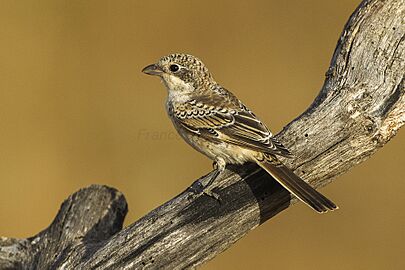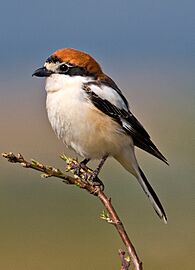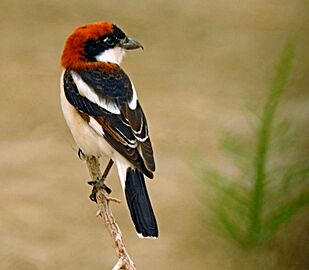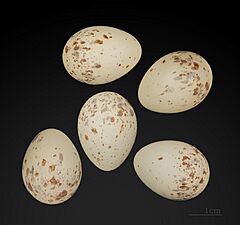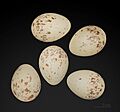Woodchat shrike facts for kids
Quick facts for kids Woodchat shrike |
|
|---|---|
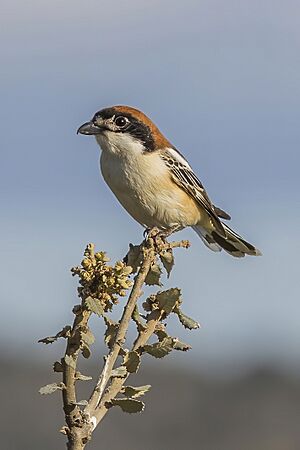 |
|
| Female L. s. senator in Spain | |
| Conservation status | |
| Scientific classification | |
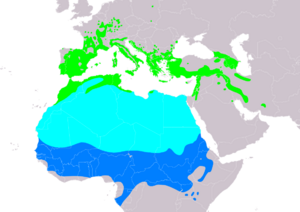 |
|
| Range of L. senator Breeding Passage Non-breeding |
The woodchat shrike (Lanius senator) is a cool bird that belongs to the shrike family. You can easily spot it by its reddish-brown head. These birds mostly eat insects. They like to live in open areas with scattered trees, like orchards, especially where the ground is bare or sandy.
Woodchat shrikes breed in southern Europe, the Middle East, and northwest Africa. When winter comes, they fly all the way to tropical Africa to stay warm.
Contents
About the Woodchat Shrike
Naming the Woodchat Shrike
The woodchat shrike got its official name, Lanius senator, in 1758. It was named by a Swedish scientist named Carl Linnaeus. He based his description on a "red headed butcher-bird" that an English naturalist had drawn earlier.
The name Lanius comes from a Latin word meaning "butcher." Some shrikes are even called "butcher birds." This is because of how they hunt and store their food. They sometimes stick their prey on thorns!
The word senator is also Latin. It means "senator," like a Roman senator. The bird's chestnut-colored cap reminded people of the colored stripe on a Roman senator's robe. The common name "woodchat" comes from a German word meaning "woodcat." "Shrike" comes from an old English word for "shriek," which describes its loud call.
Scientists have studied the genes of shrikes. They found that the woodchat shrike is closely related to the lesser grey shrike. These two species started to become different from each other millions of years ago.
Types of Woodchat Shrikes
There are three main types, or subspecies, of the woodchat shrike:
- L. s. senator – Found in central and southern Europe, and north Africa.
- L. s. badius – Lives on islands in the western Mediterranean Sea.
- L. s. niloticus – Found from Cyprus and southern Turkey all the way to Iran.
What Does a Woodchat Shrike Look Like?
The woodchat shrike is about 17 to 19 centimeters (about 7 inches) long. This makes it a bit bigger than a red-backed shrike.
Male woodchat shrikes are very striking. They have black and white on their upper bodies. Their heads have a chestnut-colored crown, and their undersides are pure white. The L. s. badius type, found in the western Mediterranean, does not have the large white patches on its wings.
Female and young woodchat shrikes look a bit different. Their upper bodies are brown and white with wavy patterns. Their undersides are a pale yellowish-brown, also with wavy patterns.
Where Do Woodchat Shrikes Live?
Woodchat shrikes breed in southern Europe, northern Africa, and the Middle East. Their breeding areas stretch from Portugal to Greece, Turkey, Iraq, and Iran. They are also found in parts of the Arabian Peninsula, like Bahrain and Kuwait. In northern Africa, they live from Mauritania to Libya.
When winter arrives, these birds fly south to tropical central Africa. Their winter homes are from Senegal to Sudan and Ethiopia in the east. They also go as far south as Gabon. Sometimes, these birds fly too far north during their spring migration. Because of this, they are sometimes seen in Great Britain, though it is rare.
Woodchat Shrike Life and Habits
Reproduction and Life Cycle
Woodchat shrikes usually lay their eggs from early May to mid-July. Both the male and female birds work together to build the nest. They usually place it in a tree, often a fruit or olive tree.
The nest is a strong cup made of plant materials. It is lined with soft things like wool, hair, fine roots, spiderwebs, and lichen. Sometimes, they even add green plant material to the nest.
A female shrike typically lays 5 or 6 eggs, one each day. The eggs are shiny and can be different colors. They might be pale olive-green, sandy, yellowish-gray, or brown. They usually have brown or pale olive speckles, especially at the wider end.
The female bird does most of the egg incubation, which means keeping them warm. The male rarely helps with this part. The eggs hatch after about 14 to 15 days. Both parents then take care of the young birds. The young shrikes are ready to fly, or fledge, after 15 to 20 days. Their parents continue to feed them for another 3 to 4 weeks after they fledge.
The oldest woodchat shrike found through bird ringing was almost 6 years old.
Food and Hunting
Woodchat shrikes mainly eat insects, especially beetles. But their diet can also include other small creatures without backbones. Very rarely, they might eat small mammals or tiny birds.
They hunt by sitting on a high spot, like a tree branch or a fence. This lookout is usually about 2 to 6 meters (6 to 20 feet) above the ground. From there, they drop or glide down to catch their prey. They also fly out to catch insects that are flying in the air.
Small insects are crushed with their beaks. Larger insects are pulled apart before being eaten. Sometimes, these birds will even stick their prey on a thorn to hold it, but this is not common. Any parts of the food that they cannot digest, like hard insect shells or bones, are coughed up as small pellets.
Woodchat Shrike Population
Even though the woodchat shrike is still common, its numbers have been going down for a long time. In Europe, it is considered a threatened species in many countries. These include France, Poland, and Switzerland.
However, because there are still many woodchat shrikes worldwide (estimated to be millions), it is listed as a "least concern" species by the IUCN. This means it is not currently in danger of disappearing.
The species has faced several big problems. These include losing their homes because of farming and too many trees being planted. Also, too much use of pesticides, climate change, and hunting during migration have hurt their numbers. A decrease in the number of insects they eat and droughts also cause problems for these birds.
Images for kids



